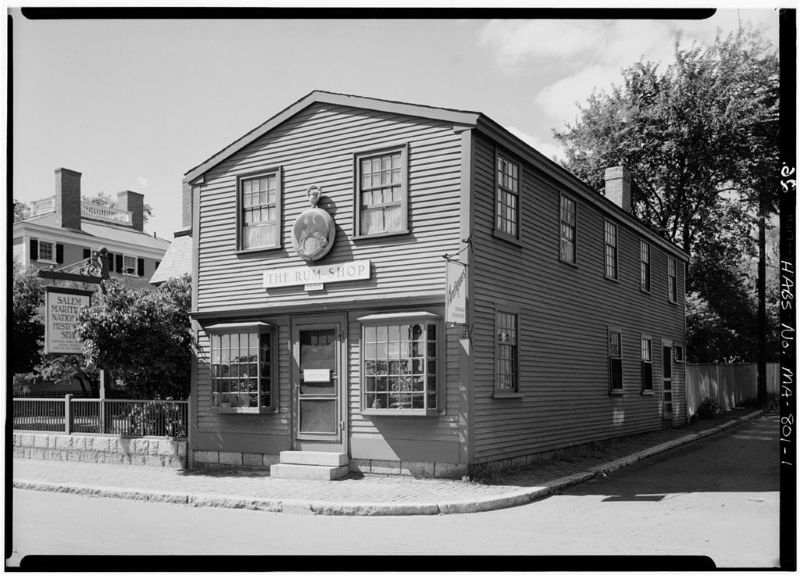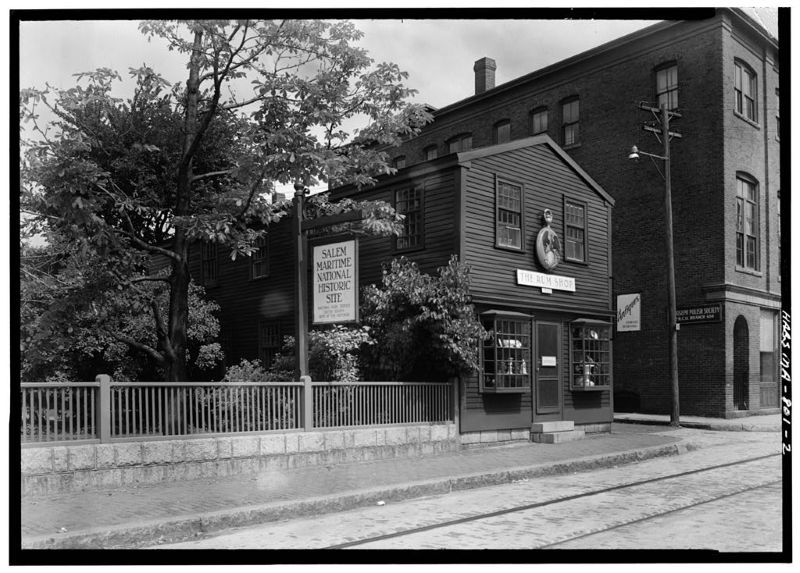The West India Goods Store is a historic commercial building on Derby Street in Salem, Massachusetts.
Built around 1800 by Captain Henry Prince, the building is a two-story wood frame building about 18 feet wide and 46 feet long. It also features a stone wall foundation and a crawl space under the first floor.
The building was probably first used as a warehouse to store cargo. By 1836, Charles Dexter had a shop in the building that sold household goods like candles, oils, glassware, and clothing, as well as grocery items, rum, and foreign imports from Europe, Asia, and Africa.
In 1827, Captain Prince’s business was in financial trouble, and he was foreclosed on by Merchants Bank of Salem, forcing him to sell his house, Derby House, and the West India Goods Store.
That same year, Merchants Bank sold the West India Goods Store to John Osgood and Henry Ropes.
From 1837 to 1851, the building was listed as a west india goods store (a general term for a store that sold imported goods from the West Indies) in the town directories.

In 1840, John Osgood quitclaimed his interest in the West India Goods Store to the Naumkeag Bank of Salem.
According to the Salem directories, the building was listed as a combination west india goods store and paint shop in 1853. The building later housed a cigar shop in 1857.
In 1861, Henry Ropes died, and his wife inherited the building. When his wife died in 1865, the building passed to their five children.
The Ropes family sold the building to the Leahy family in 1873. In 1895, the Leahy family transferred sole ownership of the building to Catherine Leahy. Catherine Leahy later sold the building to Joseph Kohn in 1911.
Sometime between 1911 and 1912, Kohn moved the building from the southeast corner of the lot to the southwest corner so that a new store building could be constructed on the southeast corner.
From 1915 to 1927, the building was used as a hairdresser shop.
In 1927, Kohn sold the building to William Appleton, Corresponding Secretary of the Society for the Preservation of New England Antiques, which is now Historic New England. SPNEA rehabilitated the building in 1928.
From 1929 to 1936, the building was used as a two-family apartment.
In November of 1937, SPNEA donated the building to the City of Salem. On December 29, the City of Salem conveyed it to the Federal Government to become part of the Salem Maritime National Historic Site.
In 1938, the building was moved again back to the southwest corner of the lot. From 1941 to 1976, a concession permit was awarded to Edward Rushford to operate an antique store in the building.
In 1947, a chimney was removed from the building, and an oil-fired heater with a new chimney was installed along the east wall of the building.
Between 1958 and 1964, Historic American Buildings Survey drawings were completed for the building.
In 1959, the building was painted, cracks and holes were repaired with white lead in oil, and the exterior was painted with a coat of lead-in-oil paint in a color that matched the already existing one.
In October of 1964, it was discovered that the building was infested by insects, possibly powderpost beetles, which were causing structural damage. The building was fumigated with cyanogen chloride to rid it of insects.
In November of 1964, the basement level was cleaned and graded, and a concrete slab was poured the following month.
Between 1964 and 1965, three composite beams were added below the existing floor joists to repair some of the insect damage. The cornice on the south elevation was removed, and some clapboards were replaced.
In January of 1965, the 1947-era chimney and heater were removed and replaced with baseboard-type heating that was connected to the central heating plant in the basement of the Custom House.

From 1976 to 1983, the building was used as a coffee shop selling West India type goods.
Due to the building’s close proximity to the street corner, in November of 1983, an automobile crashed into the southeast corner of the building. The superintendent decided to rehabilitate the building, and the work took place from January to June of 1985.
The rehabilitation work was done by the National Park Service, who decided to restore it to its 1928 appearance instead of its 1801 to 1853 appearance, when it operated as a West India Goods Store.
In 1984, there was new evidence of an insect infestation of Anobiidae, Dermestidae, and fungus beetles in the building. The building was also suffering from wood fungus. Several structural timbers were replaced, and the existing wood was treated with pesticides.
The West India Goods Store is still maintained by the National Park Service but is not open to the public for tours.
Sources:
West India Goods Store: Salem Maritime National Historic Site, Salem, Massachusetts. National Park Service, 1997, google.com/books/edition/West_India_Goods_Store/mlx1JeRkgcQC?hl=en&gbpv=1
Salem Maritime – West India Goods Store. National Parks Service, share.google/NPJ0A1irRuIvisWSM
“West India Goods Store Historical Marker.” The Historical Marker Database, hmdb.org/m.asp?m=186246
